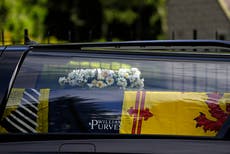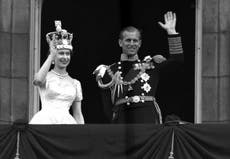The Queen’s unique sense of style spoke volumes
From the very outset of her life as monarch, Queen Elizabeth II recognised that her appearance, and therefore her wardrobe, would matter

Your support helps us to tell the story
From reproductive rights to climate change to Big Tech, The Independent is on the ground when the story is developing. Whether it's investigating the financials of Elon Musk's pro-Trump PAC or producing our latest documentary, 'The A Word', which shines a light on the American women fighting for reproductive rights, we know how important it is to parse out the facts from the messaging.
At such a critical moment in US history, we need reporters on the ground. Your donation allows us to keep sending journalists to speak to both sides of the story.
The Independent is trusted by Americans across the entire political spectrum. And unlike many other quality news outlets, we choose not to lock Americans out of our reporting and analysis with paywalls. We believe quality journalism should be available to everyone, paid for by those who can afford it.
Your support makes all the difference.How do you define the style of a monarch whose reign spanned decades of change? In recent years, Queen Elizabeth II’s wardrobe has offered a comforting familiarity to the thousands of people she has encountered on her myriad engagements.
Under the direction of her dresser and longtime personal assistant, Angela Kelly, the Queen’s wardrobe ensured that, despite her diminutive stature, she was the most visible person in the room. Colour blocking in the brightest shades with matching millinery, the aim was to appear memorable for those who had long anticipated a glimpse of the most famous woman in the world.
From the very outset of her life as monarch, Queen Elizabeth recognised that her appearance, and therefore her wardrobe, would matter. She had witnessed the challenges that could present with her own mother’s fashion choices as Queen Consort during the 1930s and 1940s. She accepted that when it came to fashion she may not be master of her own destiny.
Where her sister, Princess Margaret, might embrace the extravagances of Dior’s New Look in the late 1940s, Elizabeth was expected to support British textile manufacture and relied on the designs of London designers such as Norman Hartnell, Hardy Amies and Ian Thomas to create her royal wardrobe. They became synonymous with her appearance in the early years of her reign.
Accessories were to become the mainstay of her public style, from hats to handbags. Amongst a sea of bobbing heads, the distinctiveness of the Queen’s headwear never wavered, long after the wearing of hats had ceased to be fashionable. It was her calling card, another means by which she might stand out from those around her. As she herself would say of her determination to be visible across all platforms, “I have to be seen to be believed”.
Whilst the colours of her suits and dresses might vary in kaleidoscopic succession, some things never changed. Her shoes and her handbags were constant in their origin. For decades, the Queen carried her Launer handbag, of which she was reported to own over 200. It was the bag that sat in the crook of her arm and was so much a part of her public persona that it took a starring role in the now much-beloved skit featuring Paddington Bear created for the platinum jubilee celebrations.
Footwear was all important, and for 25 years she ordered her low-heeled court shoe from the brand Rayne. When that trusted retailer closed its doors, she took her royal seal of approval to Anello & Davide who provided her shoes for the rest of her life.
The Queen’s role as a constitutional monarch was to remain impartial, never intervening in political affairs and never voicing an opinion. With this in mind, her personal adornment came to play a role in non-verbal communication. On the occasion of President Trump’s state visit to the UK in 2018, the Queen seemed to have made some interesting jewellery choices. In a move that was dubbed “brooch warfare” on social media, she greeted the president wearing a modest moss agate brooch.
To keep up to speed with all the latest opinions and comment, sign up to our free weekly Voices Dispatches newsletter by clicking here
Eagle-eyed observers noted that it was the jewelled pin given to the Queen by the Obamas on their own state visit some years earlier. The next day, she was seen wearing the sapphire jubilee brooch, well-known as a gift from Canada. It was the most elegant of trolling from the otherwise obliging Queen.
She was, of course, well versed in the art of diplomatic dressing. Generations of royal women before her, from Queen Victoria onwards, had understood the power of sartorial flattery. From national symbols woven or embroidered onto state gowns, to the commission of a dress by a local designer, the Queen made hundreds of overseas trips with a thoughtfully constructed wardrobe that took months of planning. Her reign was to coincide with the development of colour photography and television, making these public garments all the more momentous as the press followed in their wake.
So what might we take as the Queen’s style legacy? Arguably, it is one of constancy. In a world that has changed irrevocably in the last 70 years, the Queen’s appearance has been a consistent presence. From her familiarly set coiffure to her low black heels, the Queen was always recognisably herself, and in tumultuous times, there was something strangely comforting in that.
Dr Kate Strasdin is senior lecturer in the History and Theory of Fashion at Falmouth University, and a visiting lecturer at DeTao Masters Academy in Shanghai, China




Join our commenting forum
Join thought-provoking conversations, follow other Independent readers and see their replies
Comments